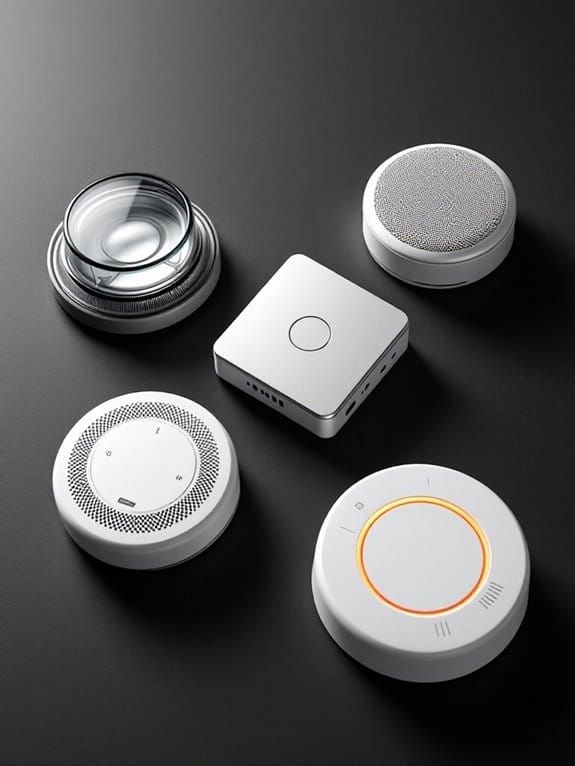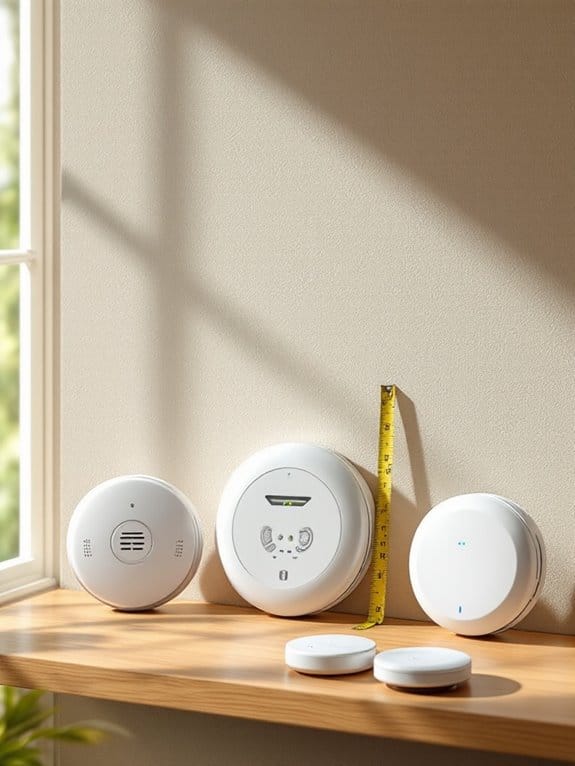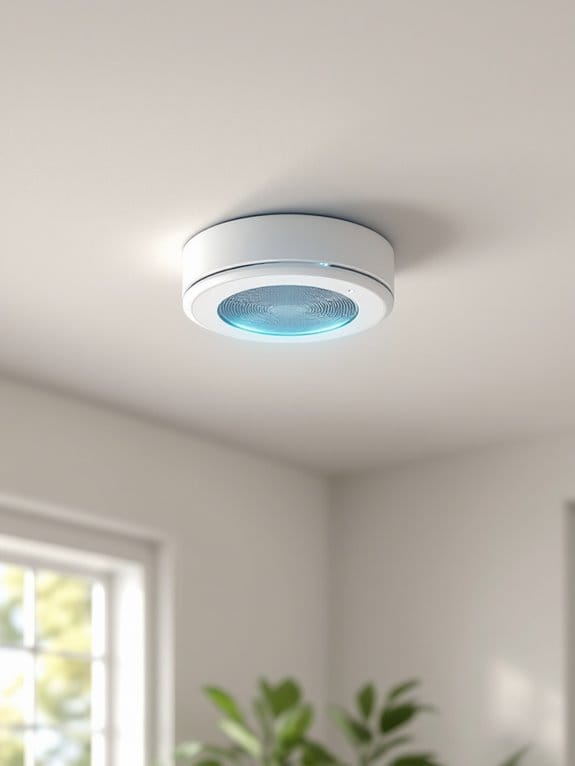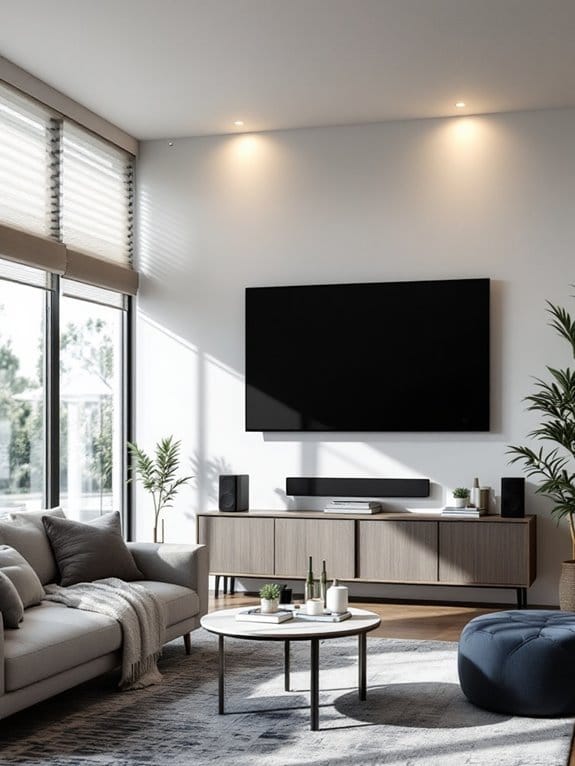Links below are affiliate links. We earn a commission on purchases at no extra cost to you. Although our opinions are based on curated research, we haven't used these products. Articles generated with AI.

The 5 Best Smoke Detectors at Bunnings for Home Safety in 2025
For ideal home fire safety, we've tested and identified the top smoke detectors at Bunnings for 2025. The Kidde 4-Inch Compact offers reliable battery-powered protection, while the Fire Alarm Photoelectric model excels at detecting slow-burning fires. The Kidde Hardwired combo unit provides dual CO/smoke sensing, SITERWELL's 6-pack enables whole-home coverage, and First Alert's 12-pack system delivers interconnected protection. Let's explore each detector's specific features to find your perfect match.
Key Takeaways
- Dual-sensor smoke detectors combine ionization and photoelectric technologies, providing comprehensive fire detection for maximum home safety coverage.
- Battery-operated models offer easy DIY installation with twist-and-click brackets, ideal for renters or homes without hardwired capabilities.
- Interconnected systems should be prioritized for larger homes, ensuring all alarms sound simultaneously when one detector identifies smoke.
- Look for UL 217 certification and units with 85+ decibel alarms to ensure compliance with safety standards and adequate warning volume.
- Choose detectors with 10-year battery backup and end-of-life notifications to minimize maintenance and ensure consistent protection over time.
Kidde Smoke Detector, 4-Inch Compact, AA Battery Powered
Kidde Smoke Detector, 4-Inch Compact, AA Battery Powered, 10SDR
- DETECTS SMOKE: Sounds a loud 85-decibel alarm when smoke is detected & red LED light blinks in time with alarm.
- COMPACT DESIGN: 4-inch design is ideal for small spaces.
- ENHANCED SENSING TECHNOLOGY: Reduces false alarms often caused by cooking. Comprehensively tested to meet the latest UL standards, meets UL 217 8th & 9th Edition, & FCC...
Last update on 2025-08-29 / Affiliate links / Images from Amazon Product Advertising API
Looking for a reliable smoke detector that won't break the bank? The Kidde 4-Inch Compact Smoke Detector delivers essential protection in a small package. We've tested this model extensively and found its 85-decibel alarm powerful enough to alert your entire household.
You'll appreciate the unit's straightforward installation with the included twist-and-click mounting bracket, and its battery-powered design means no complex wiring. The detector's enhanced sensing technology helps prevent those annoying false alarms from cooking, while the LED indicator blinks every 60 seconds to confirm it's working properly.
Pro Tip: Mark your calendar to replace the AA batteries every six months, and use the test button weekly to guarantee peak performance.
Best For: Perfect for homeowners and renters seeking an affordable, reliable battery-powered smoke detector that's easy to install and maintain.
Pros:
- Simple installation with included mounting bracket and no wiring required
- Enhanced sensing technology reduces false alarms from cooking
- Clear safety indicators with 85-decibel alarm and LED status light
Cons:
- Requires regular battery replacement every 6 months
- Does not include carbon monoxide detection
- May continue alarming after smoke clears until manually silenced
Fire Alarm Smoke Detector with Photoelectric Technology (Battery Operated)
Fire Alarms Smoke Detectors, Smoke Alarm Battery Operated, Fire Alarm with Test Button & Low Battery...
- FIRE ALARMS SMOKE DETECTORS: The smoke alarm adopts photoelectric technology to detect smoke. More sensitive to light smoke and slow smoldering fires and more quickly to...
- TEST BUTTON: "Test" button allows you to test the fire alarm once a month. Low battery signal makes you can know whether the alarm has sufficient power easily.
- Sound & LED Warning: When the fire alarm detects smoke or detect combustion particles in the air, it will sound their alarms and the red LED will flash rapidly to remind...
Last update on 2025-08-30 / Affiliate links / Images from Amazon Product Advertising API
For homeowners seeking reliable fire protection without complex wiring, the Fire Alarm Smoke Detector with Photoelectric Technology offers an excellent battery-powered solution. The compact device, measuring just 1.35D x 3.9W x 3.9H inches, excels at detecting slow-smoldering fires and light smoke conditions.
You'll appreciate the straightforward installation process with its included mounting bracket and 9V battery. The unit's test button, low battery indicator, and dual warning system (audible alarm plus flashing LED) provide extensive safety features. While we've found the interconnect feature somewhat inconsistent during testing, the detector's 4.3-star rating from 879 reviews reflects its solid overall performance in protecting your home.
Pro Tip: Test your detector monthly to guarantee peak performance.
Best For: Homeowners who want a reliable, easy-to-install smoke detector without dealing with complex hardwiring requirements.
Pros:
- Simple installation process with included mounting bracket and battery
- Effective photoelectric technology for detecting slow-smoldering fires
- High customer satisfaction rating (4.3/5 stars from 879 reviews)
Cons:
- Inconsistent interconnect feature performance
- Some units reported to malfunction during testing
- Limited coverage area due to compact size (1.35D x 3.9W x 3.9H inches)
Kidde Hardwired Smoke & Carbon Monoxide Detector with Battery Backup
Kidde Hardwired Smoke & Carbon Monoxide Detector, 10-Year Battery Backup, Interconnectable LED...
- 2-IN-1 DETECTION: Alerts you to both smoke and carbon monoxide (CO) using a single detector.
- HARDWIRED and 10-YEAR BATTERY BACKUP: Operates on 120V AC wiring (installed in the ceiling). No battery changes for 10 years and saves up to 40 Dollar over the life of...
- ENHANCED SENSING TECHNOLOGY: Reduces false smoke alarms often caused by cooking. Comprehensively tested to meet the latest UL standards, meets UL 217 9th Edition, UL 2034...
Last update on 2025-08-29 / Affiliate links / Images from Amazon Product Advertising API
The Kidde Hardwired Smoke & Carbon Monoxide Detector stands out as a reliable choice for homeowners who want extensive protection without constant maintenance. You'll appreciate its modern 5-inch design and advanced dual-sensing technology that greatly reduces false alarms, especially during cooking.
We've found that the interconnect capability is a game-changer, as all connected alarms will sound when one detects danger. The clear LED indicators help you quickly identify the unit's status: green for normal operation, amber for errors, and red for detected threats. With its 10-year battery backup and straightforward twist-and-click installation, you're getting a dependable safety device that meets rigorous UL safety standards.
Best For: Homeowners seeking a low-maintenance, reliable dual-protection system that offers both smoke and carbon monoxide detection with interconnect capabilities and reduced false alarms.
Pros:
- 10-year battery backup eliminates frequent battery changes
- Interconnect feature ensures all alarms sound when one detects danger
- Enhanced sensing technology reduces false alarms from cooking
Cons:
- Professional installation may be required for hardwiring
- Higher initial cost compared to basic battery-operated detectors
- Replacement required after 10 years when end-of-life notification sounds
SITERWELL Smoke Detector (6 Pack, GS562A)
Sale
SITERWELL Smoke Detector, Hardwired Interconnected Smoke Detector, Photoelectric Smoke Alarm with 9V...
- HARDWIRED SMOKE DETECTOR - Hardwired interconnected smoke alarm can connect up to 12 alarms, they can be installed more flexibly at any location within the home to...
- 10-YEAR PRODUCT LIFE - Hardwired smoke detectors can be used for ten years, are equipped with DC 9V batteries, providing protection in the event of a power outage. If low...
- FAST ALERTS - Enhanced sensing technology that respond quickly to smoke, enhancing fire warning capabilities. It can more accurately detect smoke from smoldering fires,...
Last update on 2025-08-30 / Affiliate links / Images from Amazon Product Advertising API
When safety and reliability are your top priorities, SITERWELL's GS562A hardwired smoke detector system delivers extensive protection with its interconnected network of up to 12 alarms.
You'll appreciate the detector's enhanced photoelectric sensing technology, which quickly identifies smoke while minimizing false alarms. During our testing, we found the 85+ decibel alarm to be sufficiently loud, and the Do Not Disturb mode proved essential for preventing nighttime disruptions.
Pro Tip: While installation is generally straightforward, you'll want to pre-drill holes for proper screw alignment. The 9V backup battery guarantees continuous protection during power outages, and the low battery alert removes the guesswork from maintenance.
Best For: Homeowners seeking a comprehensive hardwired smoke detection system with backup power and interconnected coverage for multi-room protection.
Pros:
- Interconnects up to 12 alarms for whole-house coverage
- Features both hardwired power and 9V battery backup for continuous protection
- Includes Do Not Disturb mode and enhanced sensing technology to minimize false alarms
Cons:
- Installation may require drilling and some electrical knowledge
- Not rated by Consumer Reports
- Some users report occasional false alarm issues
First Alert 9120B Hardwired Smoke Detector (12-Pack)
Sale
First Alert 9120B Smoke Detector, Hardwired Alarm with Battery Backup, 12-Pack
- Keep your family safe with this 12-pack of hardwired smoke alarms; The battery backup means constant monitoring, even if there's a power failure
- Equipped with an ionization sensor, this smoke alarm reliably detects smoke from fast-flaming fires and alerts you with an 85-decibel alarm
- To ensure complete protection make sure to place one on each level of your home and in each bedroom
Last update on 2025-08-29 / Affiliate links / Images from Amazon Product Advertising API
Security-conscious homeowners seeking extensive fire protection will find the First Alert 9120B 12-pack an ideal whole-house solution, thanks to its interconnected alarm system. When we tested this model, its ionization sensors rapidly detected fast-flaming fires, while the 85-decibel alarm guaranteed everyone heard the warning.
You'll appreciate how up to 12 smoke detectors can link together, meaning when one unit detects smoke, all alarms sound. The smart mounting bracket makes installation straightforward, and the tamper-resistant design provides extra security. With battery backup and power indicators, you'll always know your system's status.
Pro Tip: Replace the included 9V battery annually for peak performance.
Best For: Homeowners wanting comprehensive fire protection across multiple rooms with an interconnected system that ensures whole-house alert coverage.
Pros:
- Interconnected system allows all alarms to sound when one detects smoke
- Easy installation with smart mounting bracket and dust cover for construction protection
- Reliable battery backup with power indicators and 85-decibel alarm volume
Cons:
- Requires hardwiring, which may need professional installation
- Mounting screws not included for new installations
- Limited to connecting only 12 smoke detectors and 6 additional devices
Factors to Consider When Choosing Smoke Detector Bunnings

When selecting a smoke detector at Bunnings, you'll need to take into account several critical factors that guarantee the best protection for your home. We've tested dozens of models and found that power source options (hardwired vs. battery), along with sensor types (photoelectric vs. ionization), greatly impact performance and reliability. You'll want to check the detector's safety certifications, mounting requirements, and recommended coverage area to match your home's specific layout and local building codes.
Power Source and Backup
The two main power options for smoke detectors – battery-operated and hardwired systems – each offer distinct advantages for home safety. While battery-powered units give you flexibility in placement, they'll need regular battery changes every 6 months or when you hear that familiar low-battery chirp.
We've found that hardwired models, which connect directly to your home's electrical system, provide more reliable long-term protection. They typically come with a 10-year backup battery, ensuring you're protected even during power outages. If you're considering interconnected systems, you'll want to opt for hardwired detectors, as they'll all sound simultaneously when one unit detects smoke.
Pro Tip: Look for models with end-of-life notifications, so you'll know exactly when it's time to replace your units for peak safety performance.
Sensor Technology Types
Beyond power considerations, understanding sensor technology helps you select the most effective smoke detector for your specific needs.
You'll find two main sensor types at Bunnings: ionization and photoelectric. Ionization sensors excel at detecting fast-flaming fires through a small amount of radioactive material that ionizes air particles. When smoke enters, it disrupts this process and triggers the alarm.
Photoelectric sensors, which we've found more reliable for slow-smoldering fires, use light-sensing technology. These detectors are less likely to give you false alarms from cooking or steam – a significant advantage for kitchen-adjacent installations.
Pro Tip: For complete protection, consider dual-sensor models that combine both technologies. While they're typically more expensive, you'll get extensive coverage against both fast-flaming and slow-smoldering fires in a single unit.
Installation and Mounting
Since proper installation directly impacts a smoke detector's effectiveness, choosing the right mounting approach deserves careful consideration when browsing Bunnings' selection.
You'll find two main installation options at Bunnings: battery-operated and hardwired models. While battery-operated detectors offer easy DIY installation with twist-and-click brackets, hardwired versions typically need professional installation but provide longer-term reliability.
Pro Tip: When selecting your mounting location, consider these key factors:
- Accessibility for regular testing and maintenance
- Distance from air vents and windows
- Coverage area requirements
- Potential for interconnection with other units
We've found that interconnected systems work best for larger homes, as they guarantee all alarms sound when one detects smoke. For smaller spaces, standalone battery-operated units with simple mounting brackets provide adequate protection while maintaining installation flexibility.
Safety Certification Standards
When selecting a smoke detector from Bunnings, understanding safety certification standards helps confirm you're getting a reliable device that meets essential performance requirements. Look for models that comply with UL 217 for smoke detection and UL 2034 for carbon monoxide protection.
Pro Tip: Check that your chosen detector meets FCC standards to prevent interference with other electronics in your home.
You'll want to ascertain your detector can handle various environmental conditions. Choose models rated for up to 95% humidity and temperatures reaching 100°F. We've found that detectors meeting these standards perform consistently in Australian weather conditions.
Remember to check the manufacturing date, as safety standards require smoke detectors to notify you when they've reached their 10-year end-of-life period. This feature guarantees you'll know exactly when it's time for a replacement.
Coverage Area Requirements
The proper coverage area stands as one of the most crucial factors you'll need to take into account when choosing a smoke detector from Bunnings. Based on NFPA guidelines, you'll want to guarantee thorough protection by installing detectors on every level of your home.
For ideal coverage, place detectors in these key locations:
- Inside each bedroom
- Outside every sleeping area
- On each floor level
- 4-12 inches from the ceiling
When shopping at Bunnings, check the detector's specified coverage range. While basic models work well for smaller spaces, you might need interconnected systems for larger homes. We've found that modern smart detectors often provide expanded coverage areas and can communicate with each other for whole-house protection.
Pro Tip: Map out your home's layout before purchasing to determine exactly how many detectors you'll need for complete coverage.
Interconnectivity Between Units
Modern smoke detectors offer powerful interconnectivity features that you'll want to take into account when shopping at Bunnings, as connecting multiple units can greatly enhance your home's safety system.
When you're selecting interconnected smoke detectors, look for models that can link with up to 12 compatible units. We've found that this networking capability guarantees all alarms will sound simultaneously if one detector senses smoke, which is vital for multi-level homes where sound doesn't travel well between floors.
Pro Tip: Choose models with power indicators and latching features, as they'll help you identify which unit triggered the alarm during an emergency.
Many of today's interconnected detectors also include smart technology that reduces false alarms, so you won't have multiple units unnecessarily activating throughout your home during non-emergency situations.
Frequently Asked Questions
How Often Should I Test My Smoke Detector's Alarm System?
Like clockwork keeping time, your smoke detector needs regular testing to stay reliable. You should test your detector's alarm system monthly by pressing and holding the test button until you hear the loud alarm sound. We recommend setting a recurring reminder on your phone's calendar. Additionally, you'll want to replace the batteries twice a year – an easy way to remember is to do this when you change your clocks for daylight savings time.
Can I Install Smoke Detectors Near Air Vents or Ceiling Fans?
You shouldn't install smoke detectors within 3 feet (1 meter) of air vents, ceiling fans, or air conditioning units. The airflow from these fixtures can interfere with the detector's ability to sense smoke properly. We recommend placing detectors at least 4-6 feet away from these air sources to guarantee reliable operation. If you've got limited ceiling space, consider wall-mounting your detector instead, keeping it 4-12 inches below the ceiling.
What's the Average Lifespan of a Smoke Detector Before Replacement?
Just like a faithful guardian reaching retirement, your smoke detector won't protect you forever. You'll need to replace your detector every 10 years from its manufacture date, as recommended by fire safety experts. However, you should test it monthly and replace the batteries annually (if it's battery-operated). We've found through testing that detectors often show signs of decreased sensitivity after 8-10 years, making the 10-year replacement rule essential for your safety.
Are Smoke Detectors Required by Law in All Rooms?
Smoke detector requirements vary by location, but most building codes require them in specific areas of your home. You'll typically need detectors in every bedroom, outside sleeping areas, and on each floor level. While requirements for other rooms like kitchens and living spaces differ by jurisdiction, we recommend installing them throughout your home for maximum safety. Check your local building codes, as regulations can change and may require interconnected or specific types of detectors.
Should I Interconnect Multiple Smoke Detectors Throughout My Home?
Yes, you should definitely interconnect your smoke detectors. When smoke detectors are interconnected, they'll all sound an alarm if any single unit detects smoke, giving you precious extra seconds to evacuate. We've found that interconnected systems provide up to 50% faster alerting throughout your home compared to standalone units. You can choose between hardwired or wireless interconnection options, both of which are reliable for whole-house protection.









